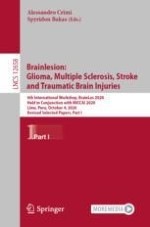2021 | OriginalPaper | Buchkapitel
Multiple Sclerosis Lesion Segmentation - A Survey of Supervised CNN-Based Methods
verfasst von : Huahong Zhang, Ipek Oguz
Erschienen in: Brainlesion: Glioma, Multiple Sclerosis, Stroke and Traumatic Brain Injuries
Aktivieren Sie unsere intelligente Suche, um passende Fachinhalte oder Patente zu finden.
Wählen Sie Textabschnitte aus um mit Künstlicher Intelligenz passenden Patente zu finden. powered by
Markieren Sie Textabschnitte, um KI-gestützt weitere passende Inhalte zu finden. powered by
